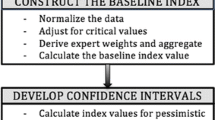Abstract
Water Service Providers (WSPs) play a critical role in delivering safe drinking water, managing wastewater, and maintaining distribution systems. Vulnerabilities facing water utilities can hinder their ability to meet community needs. This study focuses on evaluating the performance of WSPs in the Gaza Strip and identifying strengths and weaknesses. The ultimate goal is to create vulnerability maps for these providers. The methodology involves engaging key stakeholders through meetings to gather insights and knowledge. A total of 25 service providers are assessed based on 90 variables. 29 vulnerability indicators were grouped into six categories: technical vulnerability, financial vulnerability, water quality, institutional vulnerability, customer satisfaction, and reliability/quality of service. Normalization of indicators using the standard normal distribution concept allows for meaningful comparison. Geographic Information System (GIS) are employed to spatially represent vulnerability indicators across the Gaza Strip. Results are depicted in vulnerability maps, showcasing areas of concern for different WSPs. The study underscored the dynamic nature of vulnerability among the WSPs. The conclusion is drawn considering the spatial analysis, wherein the WSPs are grouped into three groups of WSPs, taking into account the concluded six vulnerability indexes. This assessment provides valuable insights into challenges facing municipalities in the Gaza Strip and emphasizes the need to address multiple aspects of vulnerability to enhance overall service delivery and resilience.










Similar content being viewed by others
References
Cashman, A. (2014). Water Security and Services in the Caribbean. Water Journal, 6(5), 1187–1203.
Cosgrove, W., & Loucks, D. (2015). Water management: Current and future challenges and research directions. Water Resource Research, 51, 4823–4839.
Cutter, S. L., Boruff, B. J., & Shirley, W. L. (2003). Social Vulnerability to Environmental Hazards. Social Science Quarterly, 84(2), 242–261.
Dong, X., Jiang, L., Zeng, S., Guo, R., & Zeng, Y. (2020). Vulnerability of urban water infrastructures to climate change at city level. Resources, Conservation and Recycling, 161, 104918.
Hemme, K. (2015). Critical Infrastructure Protection: Maintenance is National Security. Journal of Strategic Security, 8(3), 25–39.
Mack, E. A., & Wrase, S. (2017). Correction: A Burgeoning Crisis? A Nationwide Assessment of the Geography of Water Affordability in the United States. PLoS One, 12(4), e0176645.
National Institute of Standards and Technology (NIST). (2012). Risk Management Guide for Information Technology Systems. Special Publication, 800–30, Rev1. https://csrc.nist.gov/publications/detail/sp/800-30/rev-1/final
OQ. (2019). Operation and maintenance cost of large-scale water and wastewater facilities in Gaza. Office of the Quartet.
Pahl-Wostl, C., Holtz, G., Kastens, B., & Knieper, C. (2010). Analyzing complex water governance regimes: The Management and Transition Framework. Environmental Science & Policy, 13(7), 571–581.
PCBS. (2023). Labor Force Survey: Palestinian Central Bureau of Statistics. State of Palestine.
PWA & OQ. (2021). Assessment of affordability, willingness to pay, and tariff structure for water and wastewater services in the Gaza Strip. Palestinian Water Authority, the State of Palestine.
Raduszynski, T., & Numada, M. (2023). Measure and spatial identification of social vulnerability, exposure and risk to natural hazards in Japan using open data. Scientific Reports, 13, 664.
Sullivan, C. A., Meigh, J. R., & Giacomello, A. M. (2003). The Water Poverty Index: Development and application at the community scale. Natural Resources Forum, 27(3), 189–199.
Tate, E. (2012). Social vulnerability indices: A comparative assessment using uncertainty and sensitivity analysis. Natural Hazards, 63(2), 325–347.
Tyler, S., Nugraha, E., Nguyen, H. K., Nguyen, N. V., Sari, A. D., Thinpanga, P., Tran, T. T., & Verma, S. S. (2016). Indicators of urban climate resilience: A contextual approach. Environmental Science & Policy, 66, 420–426.
WHO and UNICEF. (2017) The WHO/UNICEF Joint Monitoring Programme Estimates on WASH. Available online: http://washdata.org (accessed on 25 March 2021).
WSRC. (2022). Performance Monitoring Report for Water and Wastewater Service Providers in Palestine: Water Sector Regulatory council, the State of Palestine.
Yan, Y., & Mostafavi, A. (2019). A hierarchical Bayesian network model for vulnerability assessment of water distribution systems under cascading hazards. Reliability Engineering & System Safety, 184, 26–41.
Yang, Y., Ng, S. T., Xu, F. J., & Skitmore, M. (2018). Towards sustainable and resilient high-density cities through better integration of infrastructure networks. Sustainable Cities and Society, 42, 407–422.
Yang, Y., Ng, T., Dao, J., Zhou, S., Xu, F., Xu, X., & Zhou, Z. (2021). BIM-GIS-DCEs enabled vulnerability assessment of interdependent infrastructures – A case of stormwater drainage-building-road transport Nexus in urban flooding. Automation in Construction, 125, 103626.
Acknowledgements
This research data processing is a part of a technical study carried out by the authors funded by UNICEF.
Author information
Authors and Affiliations
Corresponding author
Ethics declarations
Conflict of interest
The authors declare that they have no known competing financial interests or personal relationships that could have appeared to influence the work reported in this paper. The authors declare that they have no conflicts of interest. This article does not contain any studies involving animals performed by any of the authors.
Additional information
Publisher's Note
Springer Nature remains neutral with regard to jurisdictional claims in published maps and institutional affiliations.
Rights and permissions
Springer Nature or its licensor (e.g. a society or other partner) holds exclusive rights to this article under a publishing agreement with the author(s) or other rightsholder(s); author self-archiving of the accepted manuscript version of this article is solely governed by the terms of such publishing agreement and applicable law.
About this article
Cite this article
Eshtawi, T.A., Abdellatif, M. Spatial vulnerability assessment for water service providers: a case study from the gaza strip. GeoJournal 89, 17 (2024). https://doi.org/10.1007/s10708-024-11016-7
Accepted:
Published:
DOI: https://doi.org/10.1007/s10708-024-11016-7




